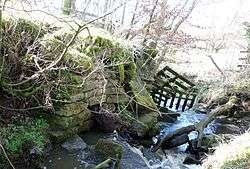Bailliehill Mount
Bailliehill Mount,[1] known locally as Bully Hill is a roughly circular earthwork[2] associated with the Iron Age, located near the village of Kilmaurs in East Ayrshire, Scotland.
| Bailliehill Mount | |
|---|---|
| Kilmaurs, East Ayrshire, Scotland | |
 Bailliehill Mount possible Iron Age Fort from the Knockentiber Road. | |
| Coordinates | 55.6256°N 4.5315°W |
| Grid reference | grid reference NS40703980 |
| Type | Earthwork |
| Height | 2 metre |
| Site information | |
| Owner | Private land |
| Open to the public | Yes |
| Condition | Plough damage |
| Site history | |
| Built | Unknown |
| Materials | Earth banks |
Location

Bailliehill Mount, also known as Woodhill Mount,[3] at 60m in height overlooks Carmyle or Waterpark Farm and the Carmel Water with steep slopes to the NW and SE; it is partly wooded. The site has well preserved rig and furrow ploughing marks internally and externally to the NE. A farmer's access track with a bridge across the Woodhill Burn at the Whin Gaw ran to the site from the nearby lane to Knockentiber.[4]
Description
Bailliehill Mount's summit has evidence of earthworks that are sub-circular[5] with an earthen bank on all sides except the NW, with an interior height of around 0.5m and an exterior height of around 2.3m.[6] An entrance may have existed to the north where the bank seems to stop short of the steep slope although that section has been subject to landslips that may have removed evidence of this part of any bank. A short section of a second bank and ditch exists to the east however the degree of rig and furrow ploughing makes interpretation problematic.[7]
History
Known locally as the 'Bullyhill' the site has been recorded as 'Bullahill' and 'Bellahill' in old church charters.[8] Robert Linton and John Smith carried out some "superficial diggings" in the mid 19th century, Robert Linton, a geologist, being the first to formally identify the site as an earthwork.[9] It was reported by Robert Linton that several stone coffins on the nearby lands of Carmyle or Waterpark were found within a cairn that was removed by the farmer and also effected by the building of the railway.[10][11] These graves show the presence of people in this area for several millennia as do other prehistoric remains in the adjoining area of Knockentiber.
The name 'Baillie' in its context of the baron-baillie, a member of a medieval lairds retinue has evoked suggestions of a link with moot hills however the name also appropriately and suggestively describes the bailey of a castle.[12] The Ordnance Survey 'name books' of 1855 to 1857 record that locals believed that Baillehill had in the distant past been a site where "justice was administered". No coffins or human remains are recorded from the site.[13]
Views of Bailliehill
 Outer ditch and bank on the SE side.
Outer ditch and bank on the SE side. Outer bank on the NE side.
Outer bank on the NE side. Outer bank and slope down to the Carmel Water.
Outer bank and slope down to the Carmel Water. Possible rig and furrow within the hill fort.
Possible rig and furrow within the hill fort.
References
Notes;
- "Canmore - Bailliehill Mount". Retrieved 16 May 2017.
- Smith, John (1895). Prehistoric Man in Ayrshire. Elliot Stock. p. 95.
- Smith, John (1895). Prehistoric Man in Ayrshire. Elliot Stock. p. 95.
- "Ayrshire, Sheet XVII. Survey date 1856. Publication date 1860". Retrieved 16 May 2017.
- Smith, John (1895). Prehistoric Man in Ayrshire. Elliot Stock. p. 95.
- "Canmore - Bailliehill Mount". Retrieved 16 May 2017.
- "Canmore - Bailliehill Mount". Retrieved 16 May 2017.
- McNaught, Duncan (1912). Kilmaurs Parish & Burgh. Alexander Gardner. p. 39.
- McNaught, Duncan (1912). Kilmaurs Parish & Burgh. Alexander Gardner. p. 39.
- "Canmore - Waterpark". Retrieved 16 May 2017.
- Smith, John (1895). Prehistoric Man in Ayrshire. Elliot Stock. p. 95.
- "Dictionary of the Scots Language". Retrieved 16 May 2017.
- "Scotland's Places". Retrieved 16 May 2017.
Bibliography
- 1. McNaught, D. (1912) Kilmaurs Parish & Burgh. Paisley:Alexander Gardener.
- 2. Smith, J. (1895) Prehistoric man in Ayrshire. London:Elliot Stock.
| Wikimedia Commons has media related to Bailliehill Mount Iron Age Fort. |